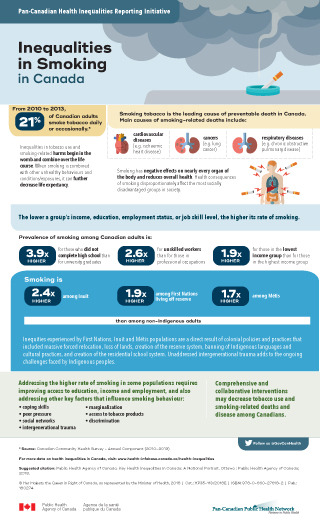Infographic: Inequalities in smoking in Canada

Download the alternative format
(PDF format, 536 KB, 1 page)
Organization: Public Health Agency of Canada
- Cat.: HP35-113/2018E
- ISBN: 978-0-660-27618-2
- Pub.: 180274
Pan-Canadian Health Inequalities Reporting Initiative
Inequalities in Smoking in Canada
From 2010 to 2013, 21% of Canadian adults smoke daily or occasionally.Footnote *
Inequalities in tobacco use and smoking-related harms begin in the womb and combine over the life course. When smoking is combined with other unhealthy behaviours and conditions/exposures, it can further decrease life expectancy.
Smoking tobacco is the leading cause of preventable death in Canada.
Main causes of smoking-related deaths include:
- cardiovascular diseases (e.g. ischaemic heart disease)
- cancers (e.g. lung cancer)
- respiratory diseases (e.g. chronic obstructive pulmonary disease)
Smoking has negative effects on nearly every organ of the body and reduces overall health. Health consequences of smoking disproportionately affect the most socially disadvantaged groups in society.
The lower a group’s income, education, employment status, or job skill level, the higher its rate of smoking.
Prevalence of smoking among Canadian adults is:
- 3.9 times higher for those who did not complete high school than for university graduates
- 2.6 times higher for unskilled workers than for those in professional occupations
- 1.9 times higher for those in the lowest income group than for those in the highest income group
Smoking is
- 2.4 times higher
- among Inuit
- 1.9 times higher
- among First Nations living off reserve
- 1.7 times higher
- among Métis
than among non-Indigenous adults
Inequities experienced by First Nations, Inuit and Métis populations are a direct result of colonial policies and practices that included massive forced relocation, loss of lands, creation of the reserve system, banning of Indigenous languages and cultural practices, and creation of the residential school system. Unaddressed intergenerational trauma adds to the ongoing challenges faced by Indigenous peoples.
Addressing the higher rate of smoking in some populations requires improving access to education, income and employment, and also addressing other key factors that influence smoking behaviour:
- coping skills
- peer pressure
- social networks
- intergenerational trauma
- marginalization
- access to tobacco products
- discrimination
Comprehensive and collaborative interventions may decrease tobacco use and smoking-related deaths and disease among Canadians.
Follow us @GovCanHealth
For more data on health inequalities in Canada, visit:
www.health-infobase.canada.ca/health-inequalities
Suggested citation: Public Health Agency of Canada. Key Health Inequalities in Canada: A National Portrait. Ottawa: Public Health Agency of Canada; 2018.
© Her Majesty the Queen in Right of Canada, as represented by the Minister of Health, 2018 | Cat.: HP35-113/2018E | ISBN: 978-0-660-27618-2 | Pub.: 180274